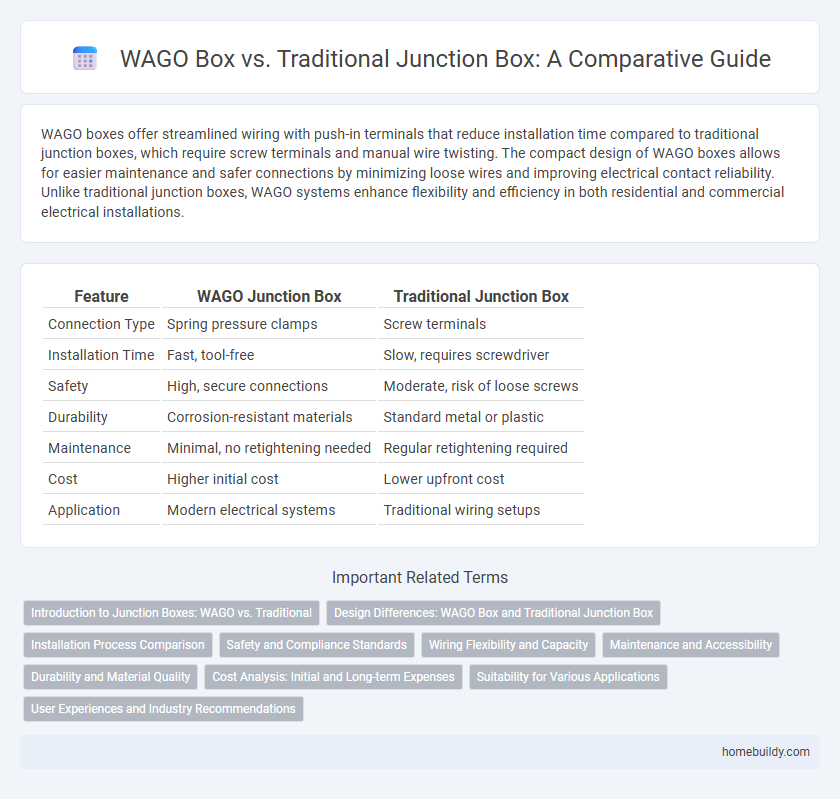WAGO boxes offer streamlined wiring with push-in terminals that reduce installation time compared to traditional junction boxes, which require screw terminals and manual wire twisting. The compact design of WAGO boxes allows for easier maintenance and safer connections by minimizing loose wires and improving electrical contact reliability. Unlike traditional junction boxes, WAGO systems enhance flexibility and efficiency in both residential and commercial electrical installations.
Table of Comparison
| Feature | WAGO Junction Box | Traditional Junction Box |
|---|---|---|
| Connection Type | Spring pressure clamps | Screw terminals |
| Installation Time | Fast, tool-free | Slow, requires screwdriver |
| Safety | High, secure connections | Moderate, risk of loose screws |
| Durability | Corrosion-resistant materials | Standard metal or plastic |
| Maintenance | Minimal, no retightening needed | Regular retightening required |
| Cost | Higher initial cost | Lower upfront cost |
| Application | Modern electrical systems | Traditional wiring setups |
Introduction to Junction Boxes: WAGO vs. Traditional
Junction boxes serve as essential enclosures for electrical wire connections, protecting and organizing wiring systems. WAGO junction boxes utilize push-in connectors for faster, tool-free wiring, enhancing installation speed and reliability compared to traditional junction boxes that rely on screw terminals. The modern WAGO design reduces wiring errors and maintenance time, making it a preferred choice in contemporary electrical installations.
Design Differences: WAGO Box and Traditional Junction Box
The WAGO box features modular, tool-free connectors that enhance wiring speed and reliability, contrasting with traditional junction boxes relying on screw terminals prone to connection errors. Its compact, transparent design enables easy inspection and maintenance, unlike bulkier traditional boxes with limited visibility. WAGO boxes also support safer, vibration-resistant connections, optimizing both installation efficiency and long-term electrical system performance.
Installation Process Comparison
WAGO junction boxes streamline the installation process with push-in spring connectors that eliminate the need for wire stripping and twisting, significantly reducing labor time and errors. Traditional junction boxes require manual wire stripping, twisting, and securing with wire nuts or screws, increasing complexity and installation time. The WAGO system enhances safety and efficiency, especially in large-scale electrical projects where consistent connections are critical.
Safety and Compliance Standards
WAGO junction boxes enhance safety by integrating spring pressure connection technology that minimizes loose wiring, reducing potential fire hazards compared to traditional screw-terminal boxes. These boxes comply with stringent international standards such as IEC 60947-7-1, ensuring reliable electrical continuity and preventing accidental disconnections. Traditional junction boxes often lack advanced compliance certifications, increasing risks in high-demand electrical environments.
Wiring Flexibility and Capacity
WAGO junction boxes offer superior wiring flexibility with tool-free, push-in connections that accommodate a wider range of wire sizes and types compared to traditional screw terminal junction boxes. Their modular design supports higher connection capacity within a compact space, reducing installation time and potential wiring errors. Traditional junction boxes often require more space and manual tightening, limiting wiring density and increasing the risk of loose connections over time.
Maintenance and Accessibility
WAGO boxes significantly reduce maintenance time due to their tool-free connection system, allowing quick inspection and rewiring compared to traditional junction boxes that require screw-tightening and can be time-consuming to access. The compact and modular design of WAGO junction boxes enhances accessibility in tight or complex installations, while traditional boxes often limit space and complicate wire organization. This streamlined accessibility and ease of maintenance make WAGO boxes ideal for minimizing downtime in electrical systems.
Durability and Material Quality
WAGO junction boxes outperform traditional junction boxes due to their use of high-quality polyamide material, which offers superior resistance to impact, chemicals, and temperature variations. Traditional junction boxes often use lower-grade plastic or metal prone to corrosion and wear, reducing longevity in harsh environments. The durable construction of WAGO boxes ensures reliable protection and a longer service life in industrial and commercial applications.
Cost Analysis: Initial and Long-term Expenses
WAGO junction boxes typically have higher initial costs due to advanced modular design and integrated features but offer reduced labor expenses and faster installation times compared to traditional junction boxes. Over the long term, WAGO boxes lower maintenance costs and minimize downtime with reliable connection technology, while traditional boxes may incur higher expenses due to regular tightening and potential faults. Investing in WAGO junction boxes results in better cost efficiency through extended durability and simplified electrical work.
Suitability for Various Applications
WAGO junction boxes provide enhanced suitability for various applications due to their modular design and ease of integration with complex wiring systems, especially in industrial automation and smart building projects. Traditional junction boxes, while reliable for basic electrical connections, often lack the adaptability and quick installation features required for advanced or large-scale setups. The WAGO system's compatibility with a wide range of wire types and its tool-free connection technology make it ideal for projects requiring flexibility and rapid deployment.
User Experiences and Industry Recommendations
WAGO junction boxes offer faster installation times and enhanced safety features compared to traditional junction boxes, reducing wiring errors and improving overall user satisfaction. Industry experts recommend WAGO boxes for their modular design, which simplifies maintenance and scalability in complex electrical systems. Users report increased reliability and reduced downtime, making WAGO junction boxes a preferred choice in both commercial and industrial applications.
WAGO box vs Traditional junction box Infographic

 homebuildy.com
homebuildy.com